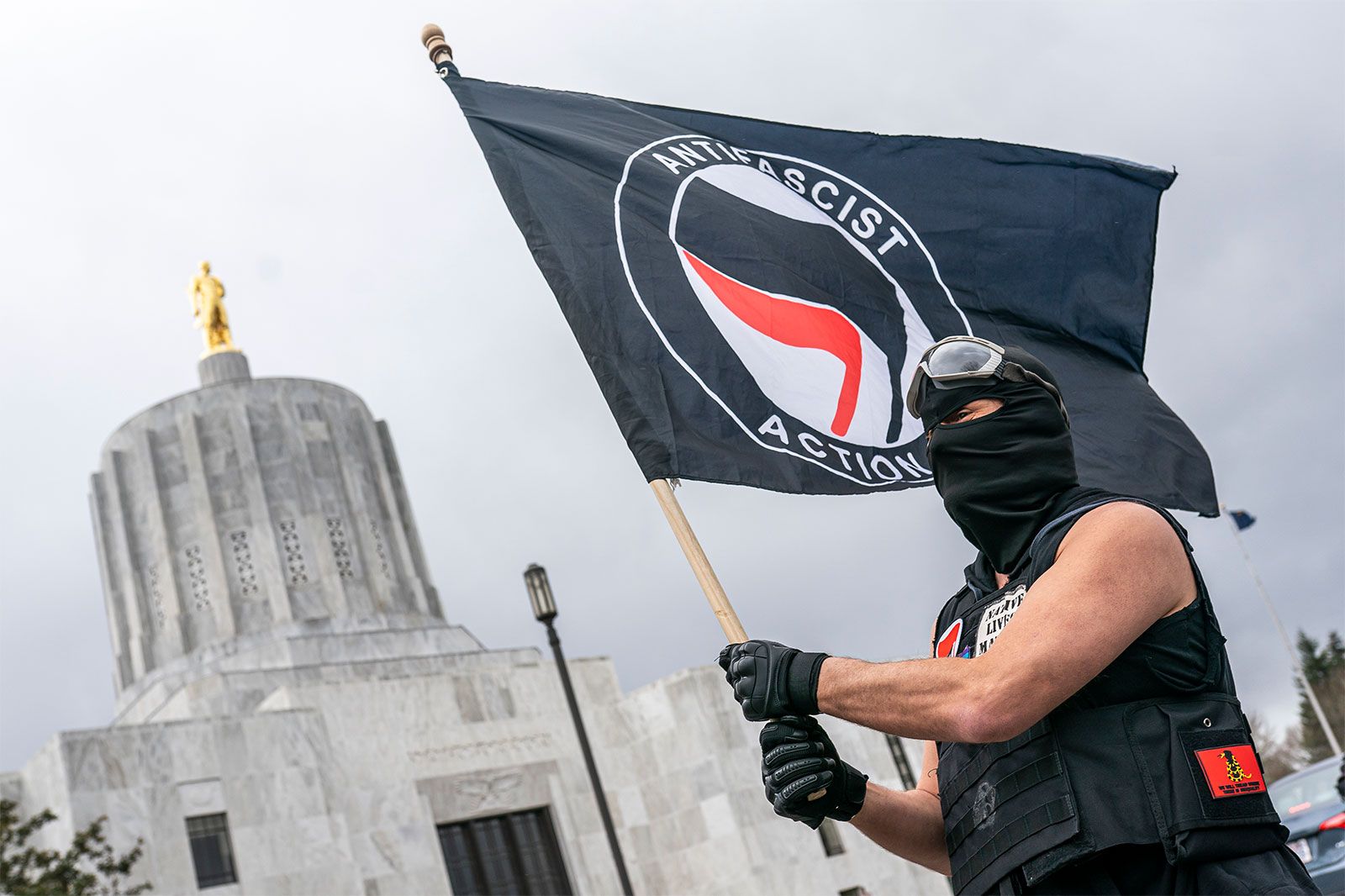
What is Antifa? Antifa, short for anti-fascist, is a decentralized network of far-left activists who oppose fascism, racism, and other oppressive ideologies. Originating in 1930s Germany to combat the rise of the Nazi Party, Antifa has evolved into a global movement. Unlike traditional organizations, Antifa operates without a central leadership, functioning through autonomous cells. This structure allows for flexibility but also makes it challenging to define or control. Antifa members often engage in protests, sometimes clashing violently with far-right groups. While their actions are controversial, their primary goal remains clear: to fight against fascism and promote social justice.
What is Antifa?
Antifa, short for anti-fascist, is a decentralized network of far-left militants in the United States. They oppose what they see as fascist, racist, or oppressive ideologies. Here are some key facts about this complex movement.
-
Definition and Origins: The term "Antifa" comes from the German word "Antifaschist," meaning "anti-fascist." It originated in the 1930s in Germany to counter the rise of the Nazi Party.
-
Decentralized Structure: Antifa operates without a central leader or headquarters. Groups work independently in autonomous cells, allowing flexibility and adaptability.
-
Leaderless Resistance: This tactic, first advocated by Louis R. Beam in 1992, involves individuals and groups acting independently without reporting to a central authority.
Activities and Protests
Antifa groups have been active in various protests and rallies, often clashing with far-right participants. Their actions have sparked significant debate and media coverage.
-
Protests and Rallies: Antifa groups frequently confront far-right rallies. A notable example is the Sacramento, California, rally in June 2016, where at least five people were stabbed.
-
Violence and Incidents: In early 2017, Antifa members clashed with alt-right demonstrators at the University of California, Berkeley, using bricks, pipes, hammers, and incendiary devices.
-
ICE Facility Attack: In July 2019, William Van Spronsen, a self-proclaimed Antifa member, attempted to bomb an ICE detention facility in Tacoma, Washington, using a propane tank but was killed by police.
Public and Media Perception
The perception of Antifa varies widely, influenced by media coverage and political rhetoric. Understanding these perspectives is crucial for a balanced view.
-
Threat Perception: According to a CSIS data set, left-wing perpetrators like Antifa made up a tiny percentage of terrorist attacks and casualties in the U.S. from January 1994 to May 2020.
-
Public Perception: During the Trump administration, "Antifa" became a conservative catch-all term for various left-leaning or liberal protest actions, leading to confusion and polarization.
-
Media Coverage: Outlets like the New York Times focus on the violence and potential threats posed by Antifa, while others emphasize the movement's anti-fascist and anti-racist goals.
Historical Context and Influence
Antifa's actions and ideologies are rooted in historical precedents and broader societal issues. Understanding this context helps explain their motivations and tactics.
-
1970s Left-Wing Activism: The 1970s saw over 2,500 domestic bombings by left-wing activists in just 18 months, driven by a belief that justice was not possible within the system.
-
Moderate Response: The lack of a moderate response from right-wing groups to violent actions by their own members can escalate the situation and lead to more violence on both sides.
-
ADL Perspective: The Anti-Defamation League notes that "Antifa" is often misapplied to include all counter-protesters, leading to confusion and further polarization.
Key Figures and Perspectives
Various scholars and analysts have weighed in on the Antifa movement, offering different perspectives on its significance and impact.
-
Alexander Reid Ross’s Perspective: Alexander Reid Ross argues that the term "Antifa" became popular in reaction to the term "alt-right." He believes it describes people who are anti-fascist or against racism and are willing to protest against it.
-
Oxford Dictionaries’ Recognition: Oxford Dictionaries placed "Antifa" on its shortlist for word of the year in 2017, recognizing its emergence as an established part of the English lexicon.
-
Pronunciation Variations: The pronunciation of "Antifa" in English is not settled, with stress on either the first or second syllable.
Conservative Reactions and Cultural Impact
Antifa has become a focal point in the broader cultural and political landscape, often used to symbolize deeper societal conflicts.
-
Conservative Reaction: Conservative writers like L. Brent Bozell III have linked the tactics of Black Lives Matter with those of Antifa, branding part of the opposition as violent and extreme.
-
Cultural War Fears: The term "Antifa" distills conservative fears about an all-out culture war, serving as a quick way to brand part of the opposition as violent and radical.
-
Decentralized Mix of Actors: The far-left includes a mix of actors like anarchists, socialists, and other anti-fascist groups, making it challenging to define a unified ideology or strategy for Antifa.
Threat Perception and Historical Precedents
Despite the media attention, the actual threat posed by Antifa is relatively small compared to other domestic extremist groups. Historical precedents offer valuable lessons.
-
Small Threat Perception: Despite public concern, Antifa-associated actors pose a relatively small threat compared to right-wing terrorists, who have perpetrated the majority of attacks and plots.
-
Historical Precedents: The 1970s bombings by left-wing activists show that similar sentiments can lead to significant violence, serving as a cautionary tale for the potential risks associated with radicalized groups.
Police Interaction and Corporate Handling
The relationship between Antifa, law enforcement, and corporations adds another layer of complexity to the movement's activities and public perception.
-
Police Behavior: Police behavior during protests involving Antifa is often criticized for inconsistency. Some argue that police employ prosocial behavior to manage protests, while others see this as manipulation or cooperation.
-
Google’s Handling: Google has faced criticism for allegedly allowing Antifa activity within the company. The failure to fire individuals involved in organizing violence has led to accusations of double standards.
-
Media Framing: Media framing of Antifa varies widely, reflecting the complexities and nuances of the movement. Balanced reporting is crucial for an accurate understanding.
Broader Societal Issues
The debate around Antifa touches on broader issues related to public debate, democracy, and faith in institutions. Addressing these issues is essential for promoting peaceful conflict resolution.
-
Public Debate: The debate around Antifa reflects broader issues related to public debate, democracy, and faith in institutions. When those in power are seen as biased and oppressive, it can lead to further polarization.
-
Moderate Response Challenges: The lack of a moderate response from right-wing groups to violent actions by their own members is a significant challenge. If peaceful options are not viable, it could escalate the situation and lead to more violence.
-
ADL’s Clarification: The ADL clarifies that "Antifa" is often misapplied to include all counter-protesters, leading to confusion and further polarization.
Key Figures and Perspectives (Continued)
Further insights from scholars and analysts help shed light on the complexities of the Antifa movement.
-
Alexander Reid Ross’s Analysis: Alexander Reid Ross argues that the term "Antifa" became popular in reaction to the term "alt-right." He believes it describes people who are anti-fascist or against racism and are willing to protest against it.
-
Oxford Dictionaries’ Recognition: Oxford Dictionaries recognized "Antifa" as a significant term by placing it on its shortlist for word of the year in 2017, reflecting its emergence as an established part of the English lexicon.
-
Pronunciation Variations: The pronunciation of "Antifa" in English is not settled, with stress on either the first or second syllable.
Conservative Reactions and Cultural Impact (Continued)
Antifa's role in the broader cultural and political landscape continues to evolve, influencing public perception and political rhetoric.
-
Conservative Reaction: Conservative writers have linked the tactics of Black Lives Matter with those of Antifa, branding part of the opposition as violent and extreme.
-
Cultural War Fears: The term "Antifa" distills conservative fears about an all-out culture war, serving as a quick way to brand part of the opposition as violent and radical.
-
Decentralized Mix of Actors: The far-left includes a mix of actors like anarchists, socialists, and other anti-fascist groups, making it challenging to define a unified ideology or strategy for Antifa.
Threat Perception and Historical Precedents (Continued)
Understanding the actual threat posed by Antifa and learning from historical precedents is crucial for addressing the movement's challenges.
-
Small Threat Perception: Despite public concern, Antifa-associated actors pose a relatively small threat compared to right-wing terrorists, who have perpetrated the majority of attacks and plots.
-
Historical Precedents: The 1970s bombings by left-wing activists show that similar sentiments can lead to significant violence, serving as a cautionary tale for the potential risks associated with radicalized groups.
Police Interaction and Corporate Handling (Continued)
The relationship between Antifa, law enforcement, and corporations continues to shape public perception and the movement's activities.
-
Police Behavior: Police behavior during protests involving Antifa is often criticized for inconsistency. Some argue that police employ prosocial behavior to manage protests, while others see this as manipulation or cooperation.
-
Google’s Handling: Google has faced criticism for allegedly allowing Antifa activity within the company. The failure to fire individuals involved in organizing violence has led to accusations of double standards.
-
Media Framing: Media framing of Antifa varies widely, reflecting the complexities and nuances of the movement. Balanced reporting is crucial for an accurate understanding.
Broader Societal Issues (Continued)
Addressing the broader societal issues related to Antifa is essential for promoting peaceful conflict resolution and fostering a healthy public debate.
-
Public Debate: The debate around Antifa reflects broader issues related to public debate, democracy, and faith in institutions. When those in power are seen as biased and oppressive, it can lead to further polarization.
-
Moderate Response Challenges: The lack of a moderate response from right-wing groups to violent actions by their own members is a significant challenge. If peaceful options are not viable, it could escalate the situation and lead to more violence.
-
ADL’s Clarification: The ADL clarifies that "Antifa" is often misapplied to include all counter-protesters, leading to confusion and further polarization.
Understanding Antifa's Complex Role
Antifa is a decentralized network of far-left militants opposing fascist, racist, or oppressive ideologies. Originating from 1930s Germany, it operates without a central leader, making it flexible but hard to track. Known for clashing with far-right groups, Antifa's actions range from protests to violent confrontations. Public perception varies, with some viewing them as defenders against fascism, while others see them as a threat. Media coverage is equally divided, reflecting the movement's complexities. Despite the attention, Antifa's threat level is relatively small compared to right-wing extremists. Historical precedents warn of potential violence if radical sentiments grow unchecked. The debate around Antifa highlights broader societal issues like democracy, public debate, and faith in institutions. Understanding Antifa requires recognizing its multifaceted nature and the broader context in which it operates.
Was this page helpful?
Our commitment to delivering trustworthy and engaging content is at the heart of what we do. Each fact on our site is contributed by real users like you, bringing a wealth of diverse insights and information. To ensure the highest standards of accuracy and reliability, our dedicated editors meticulously review each submission. This process guarantees that the facts we share are not only fascinating but also credible. Trust in our commitment to quality and authenticity as you explore and learn with us.


